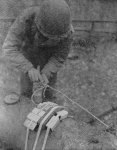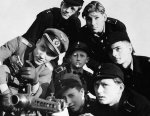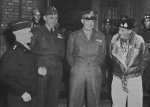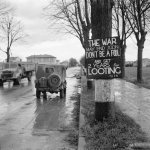My 85 year old father broke both hips (seriatim) because that thought never occurred to him.
75th anniversary of D-Day...
- Thread starter crimsonaudio
- Start date
- Status
- Not open for further replies.
Interesting. In looking through the history of my Dad's unit (244th FA Battalion). I realized that the battalion was totally reorganized after VE Day, Perhaps in preparation for reassignment to the Pacific. He was age 24 just before VE day with four years of active duty and would have been scheduled for additional combat duty had Japan not surrendered. He did fortunately have points necessary to avoid being called up for Korea.By "green," I was Thinking specifically of the pix of the youth and oldsters marching in civvies with dummy guns. OTOH, Roman soldiers had an obligation of 25 years or 16 campaigns. With a life expectancy of early-mid 40s, that was essentially a lifetime commitment. They weren't even allowed to marry until around 200 AD...
I can't promise that I won't do it again. I may do a little more conditioning beforehand. One hip's been replaced, anyway. That surgeon said, five years ago, that I had strong, sound bones. In fact, a year or so back, at my annual checkup, my family doc's nurse asked me if I'd had a bone scan lately. I said I'd had something better. She huffed up and asked what could be better. I said that the surgeon who'd cut off the top of my femur had held it in his hand and pronounced it good...My 85 year old father broke both hips (seriatim) because that thought never occurred to him.
A bit macabre, but true.
I, for one, am not hoping a doctor is holding my femur in his hand any time soon.
I, for one, am not hoping a doctor is holding my femur in his hand any time soon.
I read that the army for the invasion of Japan was going to come from three sources: troops already in the Pacific, units sent from Europe (some with a month’s leave between, some not; the latter were to go straight from Europe to the Pacific), and draftees called up to finish business in the Pacific.
From the perspective of units in Europe on VE Day, some units (a small number) would remain on occupation duty, some would go home and disband, some would go home, take a month’s leave before continuing to the Pacific and some would go straight to the Pacific.
The guys in the latter category were probably the angriest.
From the perspective of units in Europe on VE Day, some units (a small number) would remain on occupation duty, some would go home and disband, some would go home, take a month’s leave before continuing to the Pacific and some would go straight to the Pacific.
The guys in the latter category were probably the angriest.
Artillery batteries when firing were generally laid out in a “W” pattern. The distance between guns on the ground predicated on the blast radius of an HE round, so when the battery fires a salvo of one HE round, in theory, the rounds will land in the same pattern and give the battery the maximum killing for that one-round salvo.
Hitting the exact same point on the ground, however, is difficult, because every cannon will have to fire slightly different deflect and elevation.
Hitting the exact same point on the ground, however, is difficult, because every cannon will have to fire slightly different deflect and elevation.
December 6, 1944: Early in the morning and still dark in the Hurtgen, the first arrivals of the 272d Volks Grenadier Division counterattack at Bergstein. Supported by five tanks or assault guns some 300 men of the 980th Regiment take advantage of early morning haze and darkness to get almost to the village before discovery. The fight rages around the debris and the few remaining buildings of the outskirts of Bergstein. German infantry stalks the American tanks with Panzerfausts while US gunners try desperately to locate the German armor in the darkness. Even when the managed to pin their sights on the enemy vehicles, the tankers have trouble - most of the remaining American tanks are armed with 75mm rather than 76mm guns and rounds from the 75's "bounce off."
With daylight, the few American tanks equipped with the more powerful 76mm guns make quick work of the enemy armor. As the German infantry falls back, artillery fires requisitioned from both the 8th Division and the V Corps pummels the retreat. By 9AM the Allies are once again in control of Bergstein. But because the Germans hold the high ground of Castle Hill (Hill 400) near Bergstein, the enemy's big guns viciously pound the village. Twice more during the day elements of the 272d Volks Grenadier Division come out of the woods and counterattack, but they only attack in company strength and are repulsed.
Aware of the importance of Castle Hill both to the defense of Bergstein and to the accomplishment of the 8th Division's mission of reaching the Roer, both General Gerow and First Army's General Hodges approve General Weaver’s request to send 2d Ranger Battalion to support Bergstein before daylight on December 7.
Meanwhile, the 4th Infantry Division continues to defend its main line of resistance while plans are continued for the relief of the remainder of the division by the 83rd Infantry Division. US 9th Army continues attacking unsuccessfully around Juelich, and US 1st Army is plodding / fighting throughout the Forest. Elements of the US 3rd Army attack across the Sarre around Pachten and Dillengen on its northern flank and push into Sarreguemines, which is defended by German forces. US 7th Army is engaged around Montbronn, Meisentha, Mouterhouse, and Mertzwiller. In Holland, the British 2nd Army is held up southwest of Arnhem by the German demolition of dikes and the consequent flooding. The French 1st Army attacking around Ostheim and Guemar.
Over Germany, US 8th Air Force attacks Merseburg with 446 bombers, Bielefeld with 112 bombers, Minden with 140 bombers, and targets of opportunity with 64 bombers. US 15th Air Force attacks Graz. RAF Bomber Command sends 487 aircraft to attack Leuna, 453 aircraft to attack Osnabruck, 65 aircraft to attack Giessen, and 42 aircraft to attack Berlin (all overnight).
Heinkel's He 162 jet fighter made its maiden flight over Vienna. Manufacture of the He 162 was protected from Allied air attack by being built in an underground factory in a former salt mine at Tarthun near Magdeburg, Germany. The Heinkel He 162 Volksjäger (German, "People's Fighter") was a German single-engine, jet-powered fighter aircraft. Designed and built quickly, and made primarily of wood as metals were in very short supply and prioritized for other aircraft, the He 162 was nevertheless the fastest of the first generation of Axis and Allied jets.
On the eastern front, the Soviet 2nd Ukrainian Front attacking around Ercsi and Vac.
In Italy, once again the British 8th Army continues attacking toward Bologna while US 12th Air Force fighters attack targets in northern Italy in poor weather conditions.
Pictured: A British ‘flail tank’ beating the road to detonate mines, early December, 1944.; A ‘sea of mud’ in the Hurtgen.; A Heinkel He-162.; The underground facility located in Hinterbrühl, Austria that produced 40-50 He 162s per month.




With daylight, the few American tanks equipped with the more powerful 76mm guns make quick work of the enemy armor. As the German infantry falls back, artillery fires requisitioned from both the 8th Division and the V Corps pummels the retreat. By 9AM the Allies are once again in control of Bergstein. But because the Germans hold the high ground of Castle Hill (Hill 400) near Bergstein, the enemy's big guns viciously pound the village. Twice more during the day elements of the 272d Volks Grenadier Division come out of the woods and counterattack, but they only attack in company strength and are repulsed.
Aware of the importance of Castle Hill both to the defense of Bergstein and to the accomplishment of the 8th Division's mission of reaching the Roer, both General Gerow and First Army's General Hodges approve General Weaver’s request to send 2d Ranger Battalion to support Bergstein before daylight on December 7.
Meanwhile, the 4th Infantry Division continues to defend its main line of resistance while plans are continued for the relief of the remainder of the division by the 83rd Infantry Division. US 9th Army continues attacking unsuccessfully around Juelich, and US 1st Army is plodding / fighting throughout the Forest. Elements of the US 3rd Army attack across the Sarre around Pachten and Dillengen on its northern flank and push into Sarreguemines, which is defended by German forces. US 7th Army is engaged around Montbronn, Meisentha, Mouterhouse, and Mertzwiller. In Holland, the British 2nd Army is held up southwest of Arnhem by the German demolition of dikes and the consequent flooding. The French 1st Army attacking around Ostheim and Guemar.
Over Germany, US 8th Air Force attacks Merseburg with 446 bombers, Bielefeld with 112 bombers, Minden with 140 bombers, and targets of opportunity with 64 bombers. US 15th Air Force attacks Graz. RAF Bomber Command sends 487 aircraft to attack Leuna, 453 aircraft to attack Osnabruck, 65 aircraft to attack Giessen, and 42 aircraft to attack Berlin (all overnight).
Heinkel's He 162 jet fighter made its maiden flight over Vienna. Manufacture of the He 162 was protected from Allied air attack by being built in an underground factory in a former salt mine at Tarthun near Magdeburg, Germany. The Heinkel He 162 Volksjäger (German, "People's Fighter") was a German single-engine, jet-powered fighter aircraft. Designed and built quickly, and made primarily of wood as metals were in very short supply and prioritized for other aircraft, the He 162 was nevertheless the fastest of the first generation of Axis and Allied jets.
On the eastern front, the Soviet 2nd Ukrainian Front attacking around Ercsi and Vac.
In Italy, once again the British 8th Army continues attacking toward Bologna while US 12th Air Force fighters attack targets in northern Italy in poor weather conditions.
Pictured: A British ‘flail tank’ beating the road to detonate mines, early December, 1944.; A ‘sea of mud’ in the Hurtgen.; A Heinkel He-162.; The underground facility located in Hinterbrühl, Austria that produced 40-50 He 162s per month.




Where the heck were the 1st Army’s horizontal construction engineers?December 6, 1944:
.; A ‘sea of mud’ in the Hurtgen.; A Heinkel He-162.; The underground facility located in Hinterbrühl, Austria that produced 40-50 He 162s per month.

A wooden jet.December 6, 1944: ... The underground facility located in Hinterbrühl, Austria that produced 40-50 He 162s per month.

I wish more people understood (I know you do) the damage these constant bombing runs (made possible by Allied air superiority) meant regarding the Allies winning the war. We absolutely crushed their manufacturing infrastructure.A wooden jet.Way to go Jerry.
Every facility built to manufacture every little thing they needed - from steel to oil to ball bearings - was targeted.
On continued service, many troops came home, joined the reserves or the guard and, after a five year break, found themselves freezing their asses off in Korea. We knew quite a few of them, even went to church with them. The idea was that the reserve and guard were good free money because there wouldn't be another world war anytime soon. Of my two older brothers, the split was interesting. The younger, Eddie, stayed stateside and ran sub patrol off the south Florida coasts. He opted to stay in the ** reserve and finally retired as a Lt.Col. He avoided Korea through divine intervention from Senator Sparkman.* The older, Harvey, who'd spent the war in SE England in the 8th AAF, wanted nothing ever to do with flying again. He didn't even fly civilian for many years...I read that the army for the invasion of Japan was going to come from three sources: troops already in the Pacific, units sent from Europe (some with a month’s leave between, some not; the latter were to go straight from Europe to the Pacific), and draftees called up to finish business in the Pacific.
From the perspective of units in Europe on VE Day, some units (a small number) would remain on occupation duty, some would go home and disband, some would go home, take a month’s leave before continuing to the Pacific and some would go straight to the Pacific.
The guys in the latter category were probably the angriest.
*Senator Sparkman also had to help Eddie out during the Lebanon crisis in 1958. Eddie had picked up an addition occupational number after he became a CPA. There was only one digit difference between that and helicopter pilot at the time. He received letter starting out "Dear Captain Self, we see that you are classified as a helicopter pilot." It went on to give him a date to report to Dothan. He told me that he knew, if they got him down there, they'd make him a helicopter pilot, whether or not he wanted to be. As I said, the senator came to his rescue again...
An interesting topic.I wish more people understood (I know you do) the damage these constant bombing runs (made possible by Allied air superiority) meant regarding the Allies winning the war. We absolutely crushed their manufacturing infrastructure.
Every facility built to manufacture every little thing they needed - from steel to oil to ball bearings - was targeted.
The Strategic Bombing Survey (a group of AirPower advocates plus captains of American industry who interviewed German war industry officials after the war) interviewed Germans about the strategic bombing campaign to see how effective it was, what worked, and what did not.
Strat bombing made things harder for the Germans (they had to decentralize production, move it underground, get really good at repairing things).
On the other hand, the record Allied bomb tonnage month was November 1944. The record German tank production month was November 1944.
A lot of that was due to the total mobilization of German war industries which was not completed until the summer of 1944(!). In 1941-2, when the Wehrmacht was fighting the Red Army for the survival of the Reich (and losing, although few knew it at the time), German tank factories were working one eight-hour shift per day.
Stupid Army tricks.*Senator Sparkman also had to help Eddie out during the Lebanon crisis in 1958. Eddie had picked up an addition occupational number after he became a CPA. There was only one digit difference between that and helicopter pilot at the time. He received letter starting out "Dear Captain Self, we see that you are classified as a helicopter pilot." It went on to give him a date to report to Dothan. He told me that he knew, if they got him down there, they'd make him a helicopter pilot, whether or not he wanted to be. As I said, the senator came to his rescue again...
I can picture the scene:
Army Major at Ft. Rucker: “It says here you are a helicopter pilot.”
CPT Self: “Uh, no. I’m a CPA. That’s a typo.”
Major: “Well, you’re here and we need helicopter pilots. Guess what? You’re going to be a helicopter pilot with an accounting degree.” (The Army is never wrong, you see?)
I well understand your point. I first saw what appeared to be a crater when I scanned the photo. The photo does offer an on the ground view of the damage that was inflicted on German rail lines.Artillery batteries when firing were generally laid out in a “W” pattern. The distance between guns on the ground predicated on the blast radius of an HE round, so when the battery fires a salvo of one HE round, in theory, the rounds will land in the same pattern and give the battery the maximum killing for that one-round salvo.
Hitting the exact same point on the ground, however, is difficult, because every cannon will have to fire slightly different deflect and elevation.
Well, technically, by then "Air Force Major," but, yes, same story. They'd be blinded by those hundreds of hours in ASW. Helicopter pilots were in short supply and, if he accidentally picked up that skill, he could see endless activations in the future, probably dead in the middle of tax-filing season. (The ** didn't care about April 15.)Stupid Army tricks.
I can picture the scene:
Army Major at Ft. Rucker: “It says here you are a helicopter pilot.”
CPT Self: “Uh, no. I’m a CPA. That’s a typo.”
Major: “Well, you’re here and we need helicopter pilots. Guess what? You’re going to be a helicopter pilot with an accounting degree.” (The Army is never wrong, you see?)
I went to the selection course with a Staff Sergeant named Morse. After selection, every NCO gets assigned to a specialty: weapons, engineer, medic and commo. Guess which specialty SSG Morse got?Well, technically, by then "Air Force Major," but, yes, same story. They'd be blinded by those hundreds of hours in ASW. Helicopter pilots were in short supply and, if he accidentally picked up that skill, he could see endless activations in the future, probably dead in the middle of tax-filing season. (The ** didn't care about April 15.)
December 7, 1944: Three years to the day since the Japanese attacked Pearl Harbor drawing the US into WWII, the United States’ massive manufacturing and war machine is battling furiously alongside the Allies in two separate theaters, shrinking the footprint of the Axis-held area daily.
The 8th Infantry Regiment of 4th Infantry Division continues to defend its main line of resistance with its 1st and 3rd Battalions on line - patrols are sent to locate German defenses but no enemy is observed. The 12th Infantry is relieved by the 331st Infantry Regiment early in the morning. The battalions move to a temporary assembly area. By early evening the entire relief is completed. The regiment is assembled and prepares to move the following day to new area in the vicinity of the City of Luxembourg. The Commanding General of the 83rd Division assumes the responsibility for this zone of action while the Commanding General of the 4th Division assumes responsibility for the new zone of action fronting the Sauer and Moselle rivers in the vicinity of the City of Luxembourg. The 22nd Infantry passes to the control of the 4th Division and continues to defend its sector while other elements of the Division move to their new assembly areas during the day.
US 1st Army temporarily suspends its costly attacks in Hurtgen Forest while US 3rd Army is engaged around Pachten, Dillengen, Fraulautern, Ensdorf, and Sarreguemines. US 7th Army attacks around Enchenberg, Mouterhouse, and Gambsheim and French 1st Army commences operations to reduce the Colmar pocket (http://en.wikipedia.org/wiki/Colmar_Pocket).
On the eastern front, Hitler declares Budapest a fortress city. The 4th Guards Army of Soviet 2nd Ukrainian Front reach Lake Balaton and the 46th Army of Soviet 3rd Ukrainian Front captures Adony.
In Italy, British 8th Army captures Piedura and US 12th Air Force fighters attack targets in northern Italy in poor weather conditions.
Dwight Eisenhower, Bernard Montgomery, Omar Bradley, Arthur Tedder, and other Allied military leaders convened to discuss strategy. Eisenhower transferred US 9th Army to Montgomery's army group, but rejected Montgomery's notion that the southern army groups should be halted in order to make Montgomery's army group the sole attacking force.
Pictured: A GI using an effective method of clearing the road blocks so common in the Hurtgen Forest, early December, 1944.; A propaganda photo of a German officer shows boys from the Hitler youth how to use an MG-42 machine gun on December 7, 1944.; Omar Bradley, Arthur Tedder, Dwight Eisenhower, and Bernard Montgomery at Maastricht, Netherlands, December 7, 1944.; A British jeep passes a sign warning against looting on the outskirts of Ravenna, Italy, December 7, 1944.
The 8th Infantry Regiment of 4th Infantry Division continues to defend its main line of resistance with its 1st and 3rd Battalions on line - patrols are sent to locate German defenses but no enemy is observed. The 12th Infantry is relieved by the 331st Infantry Regiment early in the morning. The battalions move to a temporary assembly area. By early evening the entire relief is completed. The regiment is assembled and prepares to move the following day to new area in the vicinity of the City of Luxembourg. The Commanding General of the 83rd Division assumes the responsibility for this zone of action while the Commanding General of the 4th Division assumes responsibility for the new zone of action fronting the Sauer and Moselle rivers in the vicinity of the City of Luxembourg. The 22nd Infantry passes to the control of the 4th Division and continues to defend its sector while other elements of the Division move to their new assembly areas during the day.
US 1st Army temporarily suspends its costly attacks in Hurtgen Forest while US 3rd Army is engaged around Pachten, Dillengen, Fraulautern, Ensdorf, and Sarreguemines. US 7th Army attacks around Enchenberg, Mouterhouse, and Gambsheim and French 1st Army commences operations to reduce the Colmar pocket (http://en.wikipedia.org/wiki/Colmar_Pocket).
On the eastern front, Hitler declares Budapest a fortress city. The 4th Guards Army of Soviet 2nd Ukrainian Front reach Lake Balaton and the 46th Army of Soviet 3rd Ukrainian Front captures Adony.
In Italy, British 8th Army captures Piedura and US 12th Air Force fighters attack targets in northern Italy in poor weather conditions.
Dwight Eisenhower, Bernard Montgomery, Omar Bradley, Arthur Tedder, and other Allied military leaders convened to discuss strategy. Eisenhower transferred US 9th Army to Montgomery's army group, but rejected Montgomery's notion that the southern army groups should be halted in order to make Montgomery's army group the sole attacking force.
Pictured: A GI using an effective method of clearing the road blocks so common in the Hurtgen Forest, early December, 1944.; A propaganda photo of a German officer shows boys from the Hitler youth how to use an MG-42 machine gun on December 7, 1944.; Omar Bradley, Arthur Tedder, Dwight Eisenhower, and Bernard Montgomery at Maastricht, Netherlands, December 7, 1944.; A British jeep passes a sign warning against looting on the outskirts of Ravenna, Italy, December 7, 1944.
Attachments
-
361.8 KB Views: 3
-
76.9 KB Views: 3
-
148 KB Views: 4
-
105.7 KB Views: 4
Well, that took stones, after Market-Garden.December 7, 1944: ... Dwight Eisenhower, Bernard Montgomery, Omar Bradley, Arthur Tedder, and other Allied military leaders convened to discuss strategy. Eisenhower transferred US 9th Army to Montgomery's army group, but rejected Montgomery's notion that the southern army groups should be halted in order to make Montgomery's army group the sole attacking force.
Well, he had stones for brains, for starters. IIRC, he had multiple scenarios he proposed, all of which starred him at the head of the sole thrust into Germany...Well, that took stones, after Market-Garden.
- Status
- Not open for further replies.
Latest threads
-
-
Question: Chris Youngblood did he commit over the weekend?
- Started by mlingerfelt31
- Replies: 2
-
-
-
-





